Recent Posts
-
Yes, There IS a Future!
December 26, 2025
-
Real Crimes and the Coming Violence
September 6, 2025
-
Whither Modern Life?
June 27, 2025
-
What the Hell
June 18, 2025
-
As Darkness Engulfs Us
April 6, 2025
-
AI, Risk, and Work
January 17, 2025
-
“Things Are in the Saddle, and Ride Mankind”
December 29, 2024
-
Forgotten Futures in Seattle
December 12, 2024
-
Autocracy Defeats Neoliberalism
November 14, 2024
-
History… We’re Soaking in It!
October 2, 2024
|
I went to Mexico City over Thanksgiving to visit my wife, who is hard at work on complicated project involving a penal reform initiative there. The photos scattered through this post are from my visit, but have little to do directly with what I’m writing about.
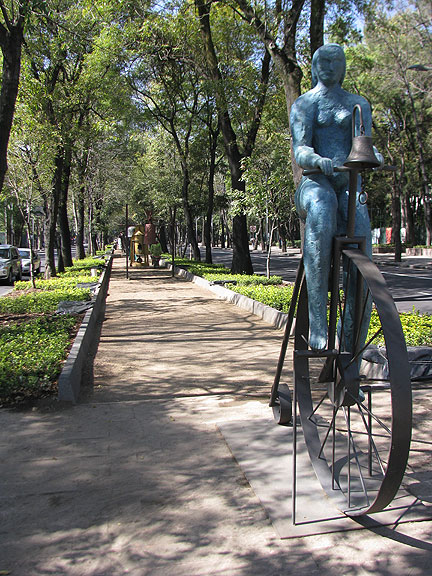 Penny-farthing riding woman in Chapultepec Park, Mexico City. I had lots of time to read and managed to whip through a couple of books while there, one about Andrew Jackson and his Indian Wars in the early 1800s (a grim story), and the other, Paul Mason’s remarkable and highly readable Why It’s Kicking Off Everywhere: The New Global Revolutions (Verso 2012). Mason’s book does a great job of putting the uprisings of 2011 in a longer-term historical context, as well as helping to emphasize that they are far from over (the past week’s new uprising in Egypt served as a loud exclamation point on this larger argument!). It complements in a fascinating way another short book I read the week before I left by Franco “Bifo” Berardi called The Uprising: On Poetry and Finance (Semiotext(e) Intervention Series No. 14). In fact, at one point Mason quotes Berardi from an essay he co-wrote with long-time cyber-theoretician Geert Lovink called “A Call to the Army of Love and to the Army of Software,” labeling Berardi as the “figurehead” of “autonomism,” and crediting it as the political theory that most influenced the exploding horizontalist social uprisings of the past year.
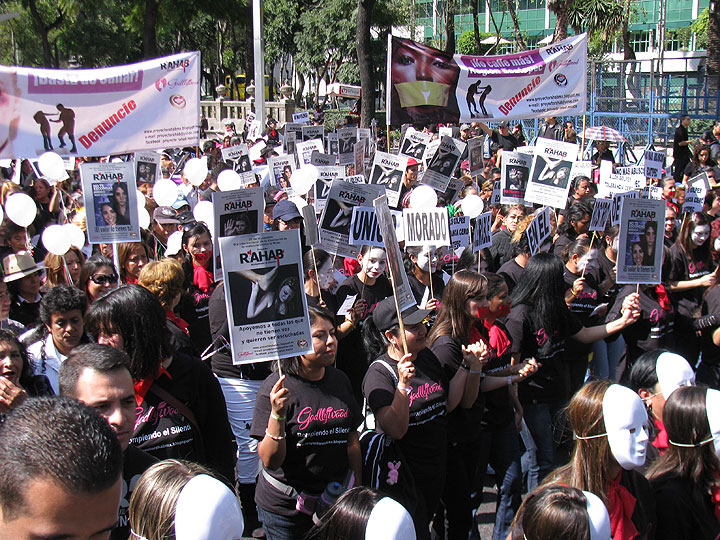 A large demo left from near our hotel on Saturday Nov. 24, part of the International Day Protesting Violence Against Women... it was probably 2000-3000 with people from all over Mexico City's neighborhoods represented. The Marxian concept of General Intellect has been inspiring to me for a while already. I wrote about it at length in Nowtopia, using the concept to contextualize the myriad ways people take their time and technological know-how out of market relations to begin producing a social and technological foundation for a post-capitalist life. The concept goes back to Karl Marx’s Grundrisse and “the Fragment on Machines” which has been heavily plumbed in the past couple of decades for its prescient analysis of the stage of capitalism we seem to be in now, more than a century after Marx first described it. The most commonly quoted piece of it is this: “The development of fixed capital indicates to what degree general social knowledge has become a direct force of production, and to what degree, hence, the conditions of the process of social life itself have come under the control of the general intellect and been transformed in accordance with it.”
Continue reading In the Trenches with General Intellect
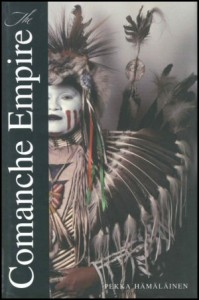 During the past several months I’ve been quite preoccupied with preparing for the 20th anniversary of Critical Mass, and a big part of that earlier this year was wrapping up the book “Shift Happens! Critical Mass at 20,” which is now out and available both in print and as a kindle e-book. And last June we traveled to Scandinavia and Spain too, so that also filled up my life for a while. During the past several months I’ve been quite preoccupied with preparing for the 20th anniversary of Critical Mass, and a big part of that earlier this year was wrapping up the book “Shift Happens! Critical Mass at 20,” which is now out and available both in print and as a kindle e-book. And last June we traveled to Scandinavia and Spain too, so that also filled up my life for a while.
All that is to say that even though I’ve been away from blogging for the most part, I still think of things I want to write about, and today, finally, I’m getting back to a topic that I had been thinking about off and on during the past six months. It started when I picked up Comanche Empire by Pekka Hämäläinen, an incredible book documenting a major piece of North American history that is barely recognized or understood. After I read that I picked up The Worst Hard Time by Timothy Egan, a breezy but well-told history of the Dust Bowl. What I realized as I started on the second book was that the stories take place separated by a little more than a half century in the exact same geographic area! Then I found a novel published by the New York Review of Books by John Williams called Butcher’s Crossing, which takes place in the years that the trade in buffalo hides peaked and collapsed in the mid-1870s, exactly when the U.S. Army was wiping out the Comanches by destroying their domestic encampments while for-profit hunters were decimating the buffalo herds on which they depended. And lastly I finally got to read my good friend Roxanne Dunbar-Ortiz’s first volume of her autobiography, Red Dirt: Growing Up Okie, about her childhood from the late 1930s to the 1950s in a small town that is later swallowed by the greater Oklahoma City metro area.
Taken together these four books provide quite an unexpected and rarely connected history of the southern Great Plains. The territory in question extends from southern Kansas and even southeastern Colorado into New Mexico and the Oklahoma and Texas panhandles, all the way to Mexico. I’d never heard of the Llano Estacado region but it figures prominently in Comanche history as well as the early histories of the Mexican provinces of Texas and New Mexico. 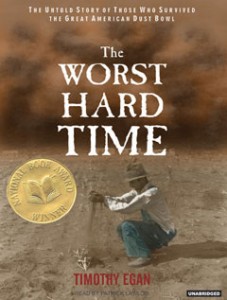 The recent prominence of Thomas Frank’s book What’s the Matter with Kansas?, in which he laments the late 20th century rise of red-state right-wing politics, underscores the Republic of Amnesia that cloaks the much longer and non-U.S.-centric history of the area. Roxanne’s memoir Red Dirt is so named to evoke the layered histories of the area, the red soil that predominates in Oklahoma, the “red skin” of the many tribes that were driven to “Indian Territory” by U.S. policy in the early 19th century, the strong socialist and Wobbly history in Oklahoma, the left-wing “reds” that created a pro-worker state constitution in Oklahoma and who were smashed during the “red scare” after World War I. The recent prominence of Thomas Frank’s book What’s the Matter with Kansas?, in which he laments the late 20th century rise of red-state right-wing politics, underscores the Republic of Amnesia that cloaks the much longer and non-U.S.-centric history of the area. Roxanne’s memoir Red Dirt is so named to evoke the layered histories of the area, the red soil that predominates in Oklahoma, the “red skin” of the many tribes that were driven to “Indian Territory” by U.S. policy in the early 19th century, the strong socialist and Wobbly history in Oklahoma, the left-wing “reds” that created a pro-worker state constitution in Oklahoma and who were smashed during the “red scare” after World War I.
The dramatic untold story is that the Comanches were an aggressive, expansive, and successful empire for over 150 years, from the early 1700s to after the U.S. Civil War, but they haven’t appeared on maps, and have not been much of a factor in most of published history. (An important exception is Caleb Galloway’s magisterial work “One Vast Winter Count” which completely reconfigures the history of North America by seeing it from the point of view of many different tribes, situating them as historic actors and makers of their own history.) Until I read Comanche Empire I didn’t really appreciate how much land the Comanches controlled, in fact I didn’t really even know where they were or how they related to other well-known Indian nations like the Apaches, the Pawnees, the Cherokees, or Creeks. I never knew how much they had successfully prevented the Spanish and then the newly independent Mexicans from consolidating and controlling their northern colonial territories, and how they developed a thriving economy based on a semi-nomadic symbiosis with vast herds of buffalo while becoming expert horse breeders, combined with “raiding and trading” along their frontiers to dominate their neighbors.
Continue reading Forgetting to Remember
What an amazing run! The San Francisco Giants have won the World Series for the second time in three years, and this time, against all odds! I just got home from walking up Mission Street from 16th Street to 24th Street, enjoying the thousands of people in the street, bonfires, music, cars honking, everyone high-fiving each other, a huge party…
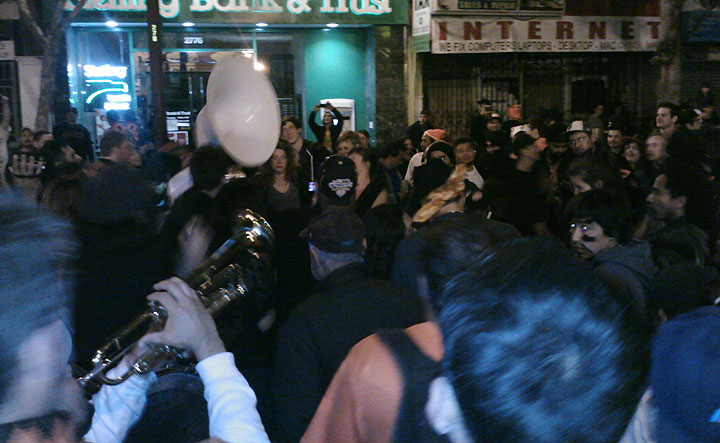 A spontaneous brass band got a dance beat on near 24th and Mission after the Giants victory. 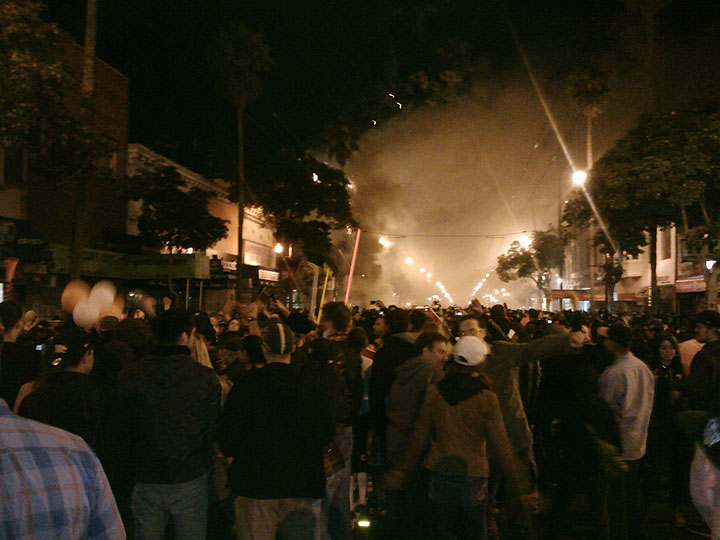 Bonfires were set up and down Mission while the honking and cheering still hasn't stopped at midnight... The game ended in 10 innings tonight, with a perfect poetic called strike three fastball down the pipe to triple-crown winner Miguel Cabrera. Sergio Romo worked his magic again and the Giants won a convincing four-game sweep, after winning an improbable six elimination games to overcome 0-2 deficit to the Cincinnati Reds and a 1-3 deficit to the St. Louis Cardinals to get to the World Series.
I decided my costume at Critical Mass on Friday night this year was to be “The Temporary Representative on Earth of the Baseball Gods” and this is what I wrote to explain it:
September: The hated Los Angeles Dodgers trade for star pitchers and hitters, and yet the Baseball Gods allow them to falter and fade, while the Giants surge ahead and win the division with ten days to spare.
The Division Series: After losing the first two games to the Cincinnati Reds at home, the Giants are held to one hit through nine innings in game 3 in Cincinnati, and yet, miraculously, they are tied 1-1 going into extra innings. In the 10th inning, the Giants manage to get runners on base and when Cincinnati third-baseman Scott Rolen bobbles a grounder with two outs (thank you Baseball Gods!), the Giants score, and win the game 2-1. The next two games are a complete turnaround for the Giants and they win 8-3 and 6-4, featuring a Buster Posey Grand Slam in game 5, as the Giants become the first team in National League history to recover from an 0-2 deficit and win three in a row in their opponents’ ballpark, and go on to the National League Championship Series.
The Championship Series: The Giants are outplayed by the St. Louis Cardinals through the first four games and find themselves in another impossible hole, down 3 games to 1, with Game 5 still to be played in St. Louis. Barry Zito is the starting pitcher for the Giants, one of the most famous busts in history with his $127-million 6-year contract having gotten the Giants four bad seasons of very subpar performances. This year, though, Zito righted his ship and the Giants were on a long winning streak when he pitched. He pitched his best game ever and the Giants won 5-0, with a key turning point coming when the Baseball Gods saw fit to have the opposing pitcher catch an easy comebacker and throw it directly into the second base bag, bouncing into center field, allowing the Giants to score their first runs of the game. The series turned on that play and from then on the Giants were on a roll, dominating St. Louis and outscoring them 20-1 for the remaining games, winning the series 4 games to 3.
The World Series: Facing the powerful Detroit Tigers and their ace Justin Verlander in Game 1, the Giants are surprised when the Panda belts a home run in the first inning. In the third inning, now leading 2-0 (again behind the surprising pitching of Barry Zito) the key moment in the game comes when with two outs Angel Pagan (could there be a more perfect name for a San Francisco ballplayer?) hits a squibber down the third base line in what should be an easy out. Instead, the Baseball Gods see to it that it hits the side of the third base bag and caroms into left field, allowing Pagan to get to 2nd base. The inspiring Marco Scutaro follows with a run-scoring single, which leads to the bizarre scene of the Detroit pitching coach walking to the mound to talk to his ace in the third inning (Verlander is considered “above” such consultations!). Verlander is not impressed, and after sharing some smirks and noting that the pitching coach’s visit has fired up the San Francisco crowd, he finally makes the next pitch to Pablo Sandoval, who promptly blasts it into the left field seats for his 2nd consecutive home run. Sandoval would hit his 3rd home run two innings later off another pitcher, giving the game the glow of something blessed and unnatural!
In Game 2, a scoreless pitching duel between Madison Bumgarner (MadBum) and Doug Fister, in the Giants 6th inning Hunter Pence leads off with a single, followed by a walk to Brandon Belt. Two on, none out, Gregor Blanco coming to bat, a known good bunter. He takes a few pitches and with a 2-1 count, gets a beautiful bunt down the third base line. The Tigers decide to let it roll foul, but it doesn’t! The Baseball Gods stop the ball perfectly in fair territory, and now the bases are loaded. The next batter, Brandon Crawford, grounds into a double play, but Pence scores the first run of the game, made possible by the eerily perfect bunt! Giants win 2-0! Continue reading The Baseball Gods are with the Giants!
|
Hidden San Francisco 2nd EDITION!

NEW 2nd EDITION NOW AVAILABLE!
Buy one here
(Pluto Press, Spring 2025)
|

















